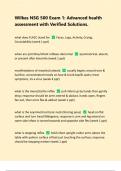Wilkes NSG 500 Exam 1: Advanced health
assessment with Verified Solutions.
what does FLACC stand for Faces, Legs, Activity, Crying,
Consolability (week 1 ppt)
when are primitive/infant reflexes abnormal asymmetrical, absent,
or present after 6months (week 1 ppt)
manifestations of measles/rubeola usually begins around ears &
hairline, concentrated mostly on face & trunk-koplik spots; treat
symptoms, its a virus (week 4 ppt)
what is the moro/startle reflex pull infant up by hands then gently
drop; response should be arms extend & abduct, hands open, fingers
fan out, then arms flex & adduct (week 1 ppt)
what is the asymmetrical tonic neck (fencing pose) head on flat
surface and turn head 90degrees; response is arm and leg extend on
same side infant is turned towards and opposite side flex (week 1 ppt)
what is stepping reflex hold infant upright under arms above the
table with palmar surface of feet just touching the surface; response
should be stepping motion (week 1 ppt)
,what is placing reflex hold infant upright under arms close to a
table and let the dorsal top of foot touch the underside of the table;
response should be flexion of the hip and knee followed by extension to
try and place foot on table (week 1 ppt)
what is rooting reflex touch/stroke cheek; response baby turns
toward stimulus (week 1 ppt)
what ages is FLACC used for 2months - 7yrs/non-verbal (week 1
ppt)
what is considered outside growth parameters less than 5% or
greater than 95% (week 1 ppt)
to what age do we measure head circumference up to 24-
36months old or if head size is questionnable like shunts or premature
births (week 1 ppt)
scalar quantity a quantity that has magnitude only, but no
directionality
what is plantar/babinski's reflex in infants stroke sole of foot;
response is smaller toes fan out and big toe dorsiflex slowly; disappears
by 12-24months (week 1 ppt)
,What does OLDCART stand for Onset, Location, Duration,
Characteristics, Aggravating, Relieving factor, Timing (week 2 ppt)
what age to expect infant to grasp a toy 1 month no; 1 yr yes (week
2 ppt)
what does HEEADSSS (assessment for adolescents Home
environment, education, Eating, Activities, Drugs, Sexuality,
Suicide/depression, Safety (week 2 ppt)
is review of systems subj or obj subjective only; physical exam is
obj. (week 2 ppt)
what are the parts of general survey apparent state of health, LOC,
signs of distress, Skin color or obvious lesions, dress/grooming/personal
hygiene (week 2 ppt)
vector quantity a quantity that has both magnitude and direction
health screening for 3yrs height, weight, BMI, vision, hearing,
language, dental, H&H, lead level, &UA if indicated (week 3 ppt)
, motor behavior at 3yrs walking, running, jumping, ride a tricycle,
walks on tiptoe, balances on one foot, builds tower on 9-10 cubes,
copies circle (week 3 ppt)
motor behavior at 4yrs skips and hops on one foot, catches ball,
uses scissors, lace shoes, copies square, 3-part stick figure (week 3 ppt)
motor behavior at 5yrs skips on alternate feet, jumps rope, learns
to skate/swim, ties shoelaces, uses pencils well, prints a few letters, 9-
part stick figure (week 3 ppt)
health screening 6-10yrs height, weight, BMI, vision, hearing,
dental (week 3 ppt)
health screening 11-12yrs height, weight, BMI, vision, hearing,
dental, cholesterol screening, annual H&H for menstruating females, UA
& STD screening for sexually active males and females, injury
prevention (week 3 ppt)
What stage is generatively vs stagnation 40-65yrs (week 3ppt)
What stage is Ego integrity vs despair 65-death (week 3ppt)




